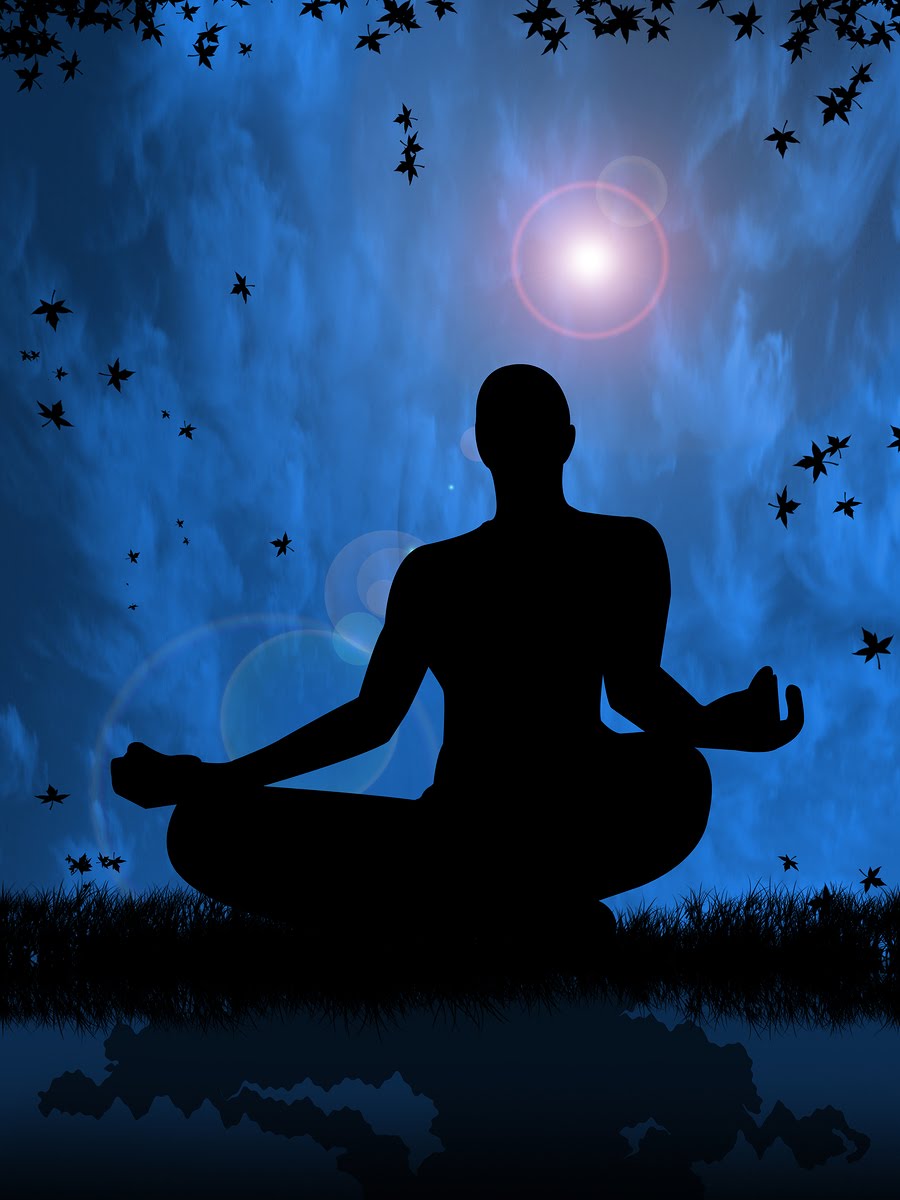From meditation to dhyana
By S-VYASA
Dhyana (dhyan meditation) is a term used for the seventh anga (limb or level) in the eight-step Yoga practice of Sage Patanjali. This state is penultimate to Samadhi or “absorption.” Unfortunately, the word dhyana is usually translated as meditation, implying a state of abiding calm. Let us briefly see what dhyana is. Earlier to practicing dhyana, the relevant steps of Yoga, namely, Yama, Niyama, Asana, Pranayama, Pratyahara, and Dharana should be practiced. The details of these steps are explained in many books dealing with the aphorisms of Sage Patanjali.[1] Yama is to abstain from violence, falsehood, theft, sensory overactivity, and acquisitiveness. Niyama is practicing purity, contentment, austerity, study of scriptures, and surrendering to a higher principle. The next two steps of asana and pranayama are well known with body postures and breathing facilitating proper gross and subtle fluid flow (blood, lymphatic, chi, and pranic flow) in the body. While practicing asana, concentration on a particular principle (e.g. infinite void) is recommended. While practicing pranayama, one should be in a state of dharana (one pointed attention). Pursuing the above limbs of Yoga, the practitioner realizes the changes in the physical and mental makeup. Pratyahara is stopping the flow of information from outside by turning the mind inward. Dharana is maintaining a single focus in the mind’s eye. Dhyana has many components; it is usually translated as meditation, which does not carry the full import of dhyana. Here, an attempt is made to present the distinction between dhyana and meditation.
Meditation is a generic word stretching from sitting quietly to deep inward focus as practiced in many traditions. The official site of National Center for Complimentary and Alternative Medicine (NCCAM), USA, proclaims thus: “Meditation techniques include specific postures, focused attention, or an open attitude toward distractions. People use them to increase calmness and relaxation, improve psychological balance, cope with illness, or enhance overall health and well-being.”[2] Thus, the definition of meditation is based on a mental process to calm and reduce psycho-physiologic load on a person due to reasons cited above. The consequence of such a practice is lowered metabolism that goes by the well-known phrase, relaxation response. Thus, in this official (and hence accepted) definition, there is no mention of the deeper levels of mentation reached in such states.
A recent paper has tried to provide taxonomy for the term meditation. Three categories of meditation are suggested based on distinct EEG profiles they seem to project. These categories are: i) focused attention (FA) (on any object), ii) open monitoring (OM), and iii) “automatic self-transcending” (ST).[3] In other words, the distinction here is based on the underlying EEG signatures for each.
The present term meditation is related to awareness – either focused or open – when the mind is focusing within an area of activity. Let us first look into the first two types, namely, FA and OM. Discussion on ST is taken up toward the conclusion of this note.
AWARENESS (FA AND OM) AND DHYANA
In awareness, at least one of the senses is active along with the mind; in dhyana, all the senses are quiet; initially, mind alone is active.[4] Mind in dhyana is focused toward its resting place, its origin, and that is said to be “the center of the being.” The symbolic lotus bud in the heart is usually turned downward; this lotus bud turns upward and opens when practices such as japa and prarthana are carried out. Thus, japa (repetition of a sacred formula) and prarthana (intense dedication) – dhyan meditation are the necessary prerequisites for dhyana.
Further, awareness has an end point that is related to acquiring or creating worldly knowledge or perhaps a touch of spiritual experience (as say, in listening to music). This is still seeking experience through and for the body and mind. In dhyana, we attempt to go beyond experience; we are at the level of ultimate reality and we are lost in that reality. This reality is not relative but an absolute one. There are no words to describe this since it is an experience beyond the mind. Hence, it is said in the ancient texts of Asia: “He who knows does not talk.”
Awareness takes us into likes and dislikes and to analyses and perhaps synthesis. The earlier (including previous life) samskaras or pre-genetic experiences and thoughts arise and are made stronger or modified as we seek new knowledge about the world and of ourselves. Dhyana is practiced to break old samskaras; it is based on total vairagya or complete detachment. All attachment to body and mind should be transcended and only the motive to reach reality should light the path to liberation. Another significant difference between awareness practices and dhyana is this: in the former, we seem to transcend the mind and seem lifeless, whereas in dhyana, we are totally aware of our state. The reason is as follows. Only Atma is endowed with consciousness and self-awareness. It is the intelligent principle activating all aspects of mind and body. Hence, any state of the mind is only a transient state and even a state such as deep sleep – wherein the mind seems to be switched off – is indeed a state of the mind. The void of deep sleep is termed jadasamadhi, a lifeless samadhi! In dhyana, Atma alone shines and hence the person is in a state of total awareness. In focused thought, there is no awareness, let alone the total awareness experienced in dhyana and samadhi states.
In dhyana, it is important we enclose a feeling of Love as the basic driving emotion. This is lacking in FA and OM meditations. This Love is not comparable to love for objects and people; it is at the highest level, Love for God or Purusha. Like an infant feeling one with its mother, we feel one with Purusha and dissolve ourselves in this feeling. Focused attention takes us away from this intense feeling of Love, whereas dhyana sustains on the Love for guru and Purusha. As in true Love, here too we Love God for the sake of God, not for any personal benefits. This Love is called Bhakti and is defined as intense longing and surrender to God with Love driving our longing. Thus, it may be said that in dhyana, deep feeling of Love is the sustaining force that binds us to Purusha.
Dhyana is again not simply staring at an image or icon of God and then closing the eyes; we try to feel one with God. Without previous training in puja, etc., our effort will only lead to churning the memory whereby good and bad recollections surface. These memories could lead us away from our goal of dhyana. Only when we feel the connection and Love for God, dhyana starts (dhyan meditation). It should be noted that a blankmind is not one in dhyana. When we experience an object with one of our senses, it is conveyed to the mind which then presents it to the Self. It is the Self or Purusha that ultimately experiences the object. Mind and all its derivatives are like the wires in a telephone network; they just communicate but have no consciousness of their own. Like the wires in this example, mind may distort the message; mind adds its own component to the sensory data based on its biases and preferences. Mind is always dynamic, seeking outlet to its fantasies and resting never. Note that mind could be fluctuating all the time though it is devoid of consciousness; the waves in an ocean are not intelligent, yet they are active all the time due to many extraneous reasons.
The model presented in Yoga Sutras is as follows. Mind interacts with the world and this interaction has three components; they are: the mind itself, the object, and the process of interaction. A term samapatti is used to distinguish the three modes.[5] The object, the mind, or the process of observation could be the focus in each type of samapatti. In FA the object is in focus, while in OM the process is being observed. In automatic self-transcendence (ST), it is likely that the mental modifications are arrested. ST starts with japa and dedication. As we advance in meditation practice, japa (on a mystical syllable) also falls off.
The author says:
“The category of automatic self-transcending is marked by the absence of both (a) focus and (b) individual control or effort…. Focus and monitoring experience are active mental processes, which keep the brain engaged in specific processing – individual activity keeps the mind from transcending. Thus, automatic self-transcending appears to define a class of meditations distinct from both focused attention and open monitoring” (3, p. 1111). dhyan meditation
With concentration on a mystical mantra, and with Love and dedication to a higher principle, the person is moving from meditation to dhyana! Purusha in Yoga or Self shines of its own accord to a person in deep dhyana and the person is ready for samadhi states. Thus, the taxonomy proposed[4] is of great interest to authenticate the Yogic model of interaction of the mind with the external world and the ways to transcend its workings to reach a state of oneness with the Self. This is the starting point of deep dhyana and a requirement for liberation.
Thus, it is seen that there is a distinction between meditation and dhyana. As many researchers have reported, meditation is to calm the body–mind complex, reduce stress, and achieve normal homeostasis. Meditation may also confer a glimpse of “bliss” that advanced yogis report. Unless there is deep-seated Love and reverence for an eternal principle, meditation may not be translated as dhyana.
Download the PDF : from-meditation-to-dhyana_unlocked
REFERENCES:
1. Devananda SV. “Meditation and Mantras”. N.Y, USA: OM Lotus Publishing Company; 1981.
2. NCCAM; Web site: Available from: http://www.nccam.nih.gov/cam basics [Last accessed on 2012 July 15].
3. Travis F, Shear J. Focused attention, open monitoring and automatic self- transcending: Categories to organize meditations from Vedic, Buddhist and
2
International Journal of Yoga Vol. 6 Jan-Jun-2013
[Downloaded from http://www.ijoy.org.in on Friday, July 29, 2016, IP: 14.139.155.82]
Srinivasan: From meditation to dhyana
Chinese traditions. Consciousness and Cognition, Vol. 19. Elsevier; 2010.
p. 1110 -8.
4. Bhajanananda A. Dhyanam (in Tamil), Sri Ramakrishna Mutt Publications,
Chennai 600004, India, 2006. This is an excellent source for understanding dhyana and many teachings of Yoga and Upanishads.
5. Srinivasan TM. “Yoga Sagara Saram”, Bangalore, India: Swami Vivekananda Yoga Prakasana; 2011. p. 106-7.
Religion World is one and only indian website to give information of all religions. We are dedicated to present the religions. You can send any info, news, engagements and advice to us on – religionworldin@gmail.com – or you can WhatsApp on – 9717000666 – we are also on Twitter, Facebook and Youtube.









